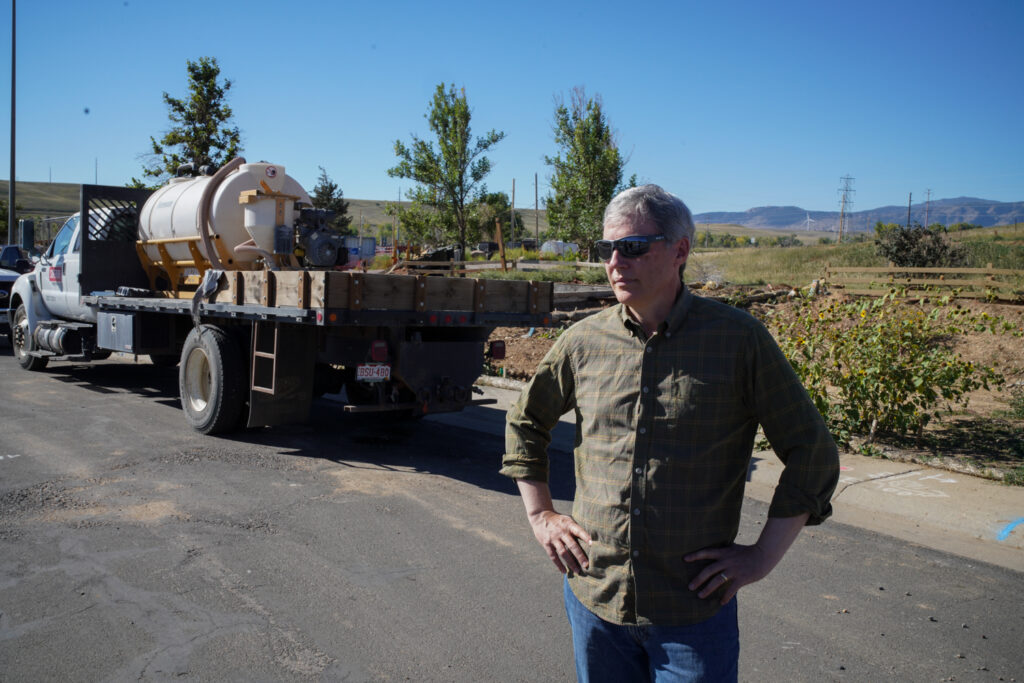This climate-friendly house for Marshall fire victims isn't a luxury home - Colorado Public Radio
- Get link
- X
- Other Apps
Andrew Michler, a passive house designer behind the new project, said the task requires a major shift in his industry. Instead of one-off homes built for committed environmentalists, passive home designers need to start building for the mass market. He said only about 20 homes in Colorado have met international passive home standards.
"It's new for us. Designers are still getting used to building the standard, typical American home," Michler said.
Michler partnered with Seattle architect Rob Harrison and Joubert Homes, a local construction company, for the project.
 Sam Brasch/CPR News
Sam Brasch/CPR NewsThe final design relies on simplicity to control costs. The exterior looks like two Monopoly homes placed in an L-shape centered around an independent two-car garage, ensuring space for storage and automobiles isn't included in the home's heavily insulated shell. A pair of gabled roofs call back to Boulder County's architectural past as a mining community.
A suite of government incentives will bring costs down further. All-electric appliances qualify buyers for an additional $10,000 state incentive. Xcel Energy, Colorado's largest power company, has offered a $37,500 discount for fire victims who rebuild to passive home standards. Smaller rebates are available for homes built with less-stringent green building standards.
Factoring in those discounts, Michler's team expects it can build one of the homes for $211 per square foot. Last February, the Colorado Association of Home Builders estimated the cost to rebuild standard homes in the Marshall fire burn area would range between $260 and $300 per square foot.
Christine Berg, a senior policy advisor for the Colorado Energy Office focused on local government, said the RESTORE project is only one of the green building plans enticing Boulder County families. Data from her office show that 95 households have filed permits to rebuild homes in the burn area. Of those, 39 owners have either registered with Xcel Energy for green building rebates or appear to qualify. She said three families have already registered to receive the largest discount available for passive homes.
"Out of this tragedy comes this great opportunity to really rethink how we build," Berg said.
 Hart Van Denburg/CPR News
Hart Van Denburg/CPR NewsA new building standard for a new climate
If all goes according to plan, the RESTORE Passive Home should offer the benefits of Michler's own house in the mountains above Loveland.
The modern cottage is nestled beneath a peaked, metal roof. In 2016, it became the first Colorado home certified under international passive house standards.
A quick tour inside reveals an open-concept layout built atop plywood flooring. Deep benches in front of each triple-paned window benches show the walls are as thick as a car tire. Michler said the required heft adds an extra benefit in fire-prone areas: It rules out the possibility of any complex architecture that might trap wildfire embers.
Another advantage is indoor comfort, Michler said. Body heat and sunlight are often enough to heat the home in the winter. In the RESTORE Passive Home, minimal energy needs should allow for far smaller heating and cooling appliances, allowing builders to recover some of the additional costs spent on extra insulation.
Out of all those advantages, it was the possibility of improved indoor air quality that sold Peter and Michelle Ruprecht on the project.
 Hart Van Denburg/CPR News
Hart Van Denburg/CPR NewsPassive home certification requires an airtight seal, which means builders include systems to filter outdoor air before it's brought indoors. Ruprecht said the feature seems critical as climate change leads to more ozone pollution and wildfire smoke on the Front Range.
"People are going to want to snatch it up because they could be living in an environment with fresh air, all the time," she said.
To her frustration, the RESTORE Passive Home has been slow to catch on among other Marshall fire victims, but interest is rising. Two other families have signed a letter of intent, Michler said. He's received about a dozen serious inquiries.
Ruprecht hopes the team steps up its marketing efforts before families sign up with other builders. She's excited to move into her own fire-resistant, climate-ready home — but would prefer to see similar models fill her neighborhood.
- Get link
- X
- Other Apps
Comments
Post a Comment